 W
WFrom 1868 onwards, Bismarck monuments were erected in many parts of the German Empire in honour of the long-serving Prussian minister-president and first German Reichskanzler, Prince Otto von Bismarck. Today some of these monuments are on the soil of other countries including France, Poland and Russia as well as the former German colonies on other continents.
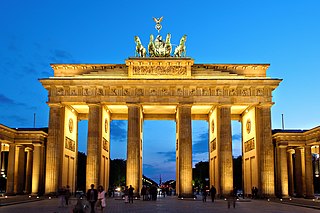 W
WThe Brandenburg Gate is an 18th-century neoclassical monument in Berlin, built on the orders of Prussian king Frederick William II after the temporary restoration of order during the Batavian Revolution. One of the best-known landmarks of Germany, it was built on the site of a former city gate that marked the start of the road from Berlin to the town of Brandenburg an der Havel, which used to be the capital of the Margraviate of Brandenburg.
 W
WCentaurea cyanus, commonly known as cornflower or bachelor's button, is an annual flowering plant in the family Asteraceae native to Europe. In the past, it often grew as a weed in cornfields, hence its name. It is now endangered in its native habitat by agricultural intensification, particularly by over-use of herbicides. However, Centaurea cyanus is now also naturalised in many other parts of the world, including North America and parts of Australia through introduction as an ornamental plant in gardens and as a seed contaminant in crop seeds.
 W
WThe national colours of the Federal Republic of Germany are officially black, red, and gold, defined with the adoption of the West German flag as a tricolour with these colours in 1949. As Germany was divided into West Germany and East Germany beginning in 1949 and continuing through 1990, both Germanies retained the black, red, and gold colors on each respective flag. After German reunification in 1990, West and East Germany adopted the West German flag as the flag of the reunited Germany, therefore maintaining black, red, and gold as Germany's colors.
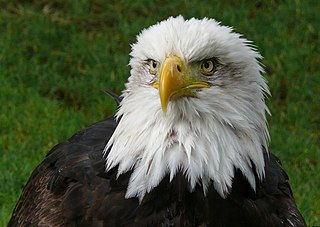 W
WEagle is the common name for many large birds of prey of the family Accipitridae. Eagles belong to several groups of genera, some of which are closely related. Most of the 60 species of eagle are from Eurasia and Africa. Outside this area, just 14 species can be found—2 in North America, 9 in Central and South America, and 3 in Australia.
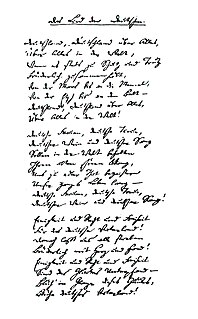 W
WThe "Deutschlandlied", officially titled "Das Lied der Deutschen", or part of it, has been the national anthem of Germany since 1922. In East Germany, the national anthem was "Auferstanden aus Ruinen" between 1949 and 1990.
 W
WThe Elsässisches Fahnenlied was written by Emil Woerth (1870-1926) in German when Alsace-Lorraine was part of the German Empire (1871-1918). It was adopted as the official anthem of Alsace-Lorraine in 1911.
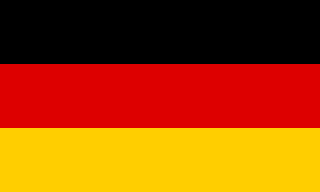 W
WThe flag of Germany is a tricolour consisting of three equal horizontal bands displaying the national colours of Germany: black, red, and gold. The flag was first sighted in 1848 in the German Confederation; with it being officially adopted as the national flag of the Weimar Republic from 1919 to 1933, and again being in use since its reintroduction in West Germany in 1949.
 W
WThe Freedom Bell in Berlin, Germany, is a bell that was given as a gift from Americans to the city of Berlin in 1950 as a symbol of anti-communism, and was inspired by the American Liberty Bell. Since 1950, the bell has been located in the Rathaus Schöneberg, the former city hall of West Berlin.
 W
WIn 1871 a design and a model for a new state crown were created to reflect the new German Empire. The model was based upon the Crown of the Holy Roman Empire and was kept in the Hohenzollern museum at Schloss Monbijou in Berlin, until it disappeared during World War II. It has never re-surfaced. No final crown was ever made. However, the design was used as a heraldic device for the German Kaisers from 1871 until Kaiser Wilhelm's abdication in 1918. The crown was most used as an heraldic symbol, in the German coat of arms and the Emperor's personal standard.
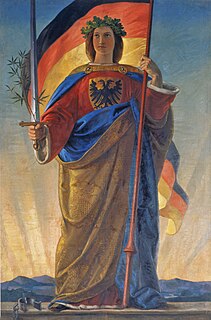 W
WGermania is the personification of the German nation or the Germans as a whole, most commonly associated with the Romantic Era and the Revolutions of 1848, though the figure was later used by Imperial Germany.
 W
WThe coat of arms of Germany displays a black eagle with a red beak, a red tongue and red feet on a golden field, which is blazoned: Or, an eagle displayed sable beaked langued and membered gules. This is the Bundesadler, formerly known as Reichsadler. It is one of the oldest coats of arms in the world, and today the oldest national symbol used in Europe.
 W
W"Ich hab′ mich ergeben", originally titled "Gelübde" ("Vow"), is a German patriotic song. The text was written in 1820 by Hans Ferdinand Maßmann. It was one of the unofficial national anthems of West Germany from 1949 to 1952, when the "Deutschlandlied" was officially reinstated. Its tune is now used in the Micronesian national anthem.
 W
WThe Imperial law regarding the introduction of a war and civil ensign was an imperial law of the revolutionary German Empire of 1848. It describes the colours black-red-gold and the usage of a general German imperial flag and a war ensign for the Imperial Fleet.
 W
WThe Reichsadler is the heraldic eagle, derived from the Roman eagle standard, used by the Holy Roman Emperors and in modern coats of arms of Germany, including those of the Second German Empire (1871–1918), the Weimar Republic (1919–1933) and Nazi Germany (1933–1945).